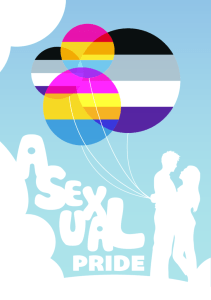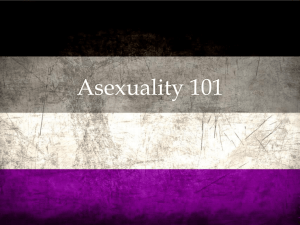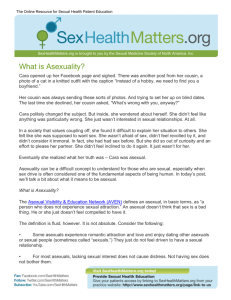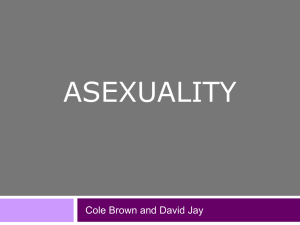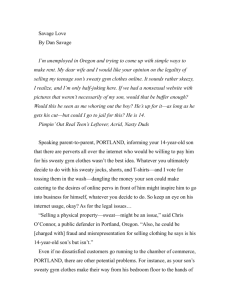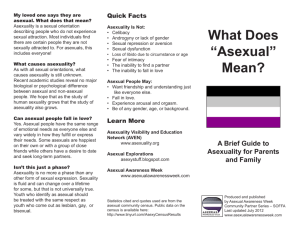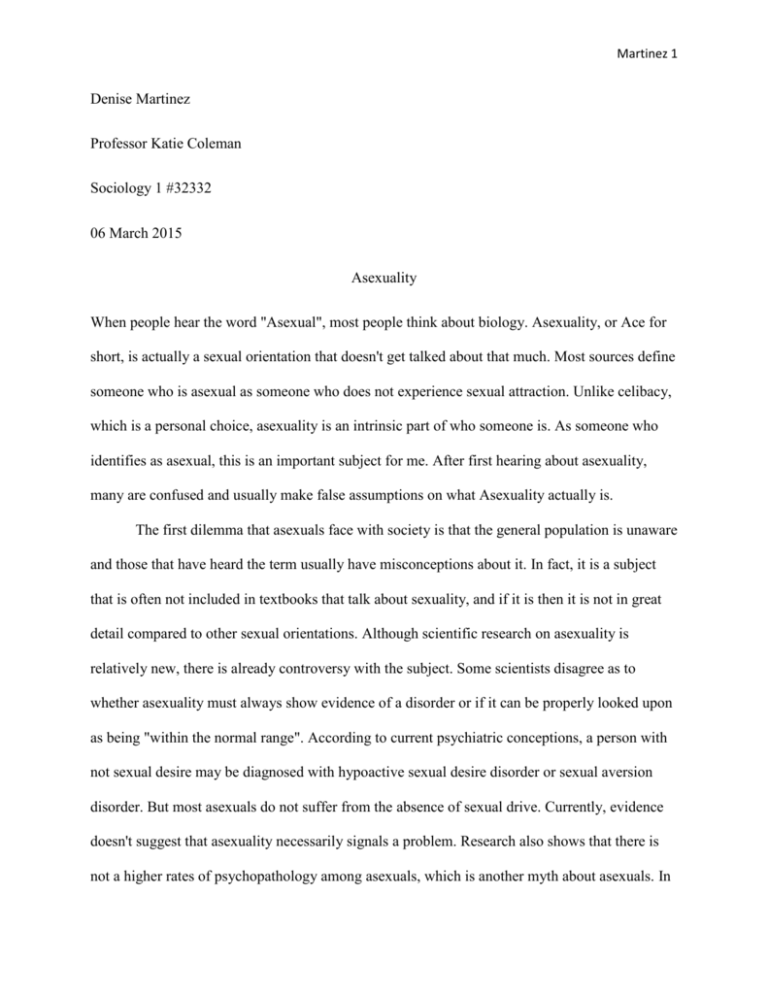
Martinez 1
Denise Martinez
Professor Katie Coleman
Sociology 1 #32332
06 March 2015
Asexuality
When people hear the word "Asexual", most people think about biology. Asexuality, or Ace for
short, is actually a sexual orientation that doesn't get talked about that much. Most sources define
someone who is asexual as someone who does not experience sexual attraction. Unlike celibacy,
which is a personal choice, asexuality is an intrinsic part of who someone is. As someone who
identifies as asexual, this is an important subject for me. After first hearing about asexuality,
many are confused and usually make false assumptions on what Asexuality actually is.
The first dilemma that asexuals face with society is that the general population is unaware
and those that have heard the term usually have misconceptions about it. In fact, it is a subject
that is often not included in textbooks that talk about sexuality, and if it is then it is not in great
detail compared to other sexual orientations. Although scientific research on asexuality is
relatively new, there is already controversy with the subject. Some scientists disagree as to
whether asexuality must always show evidence of a disorder or if it can be properly looked upon
as being "within the normal range". According to current psychiatric conceptions, a person with
not sexual desire may be diagnosed with hypoactive sexual desire disorder or sexual aversion
disorder. But most asexuals do not suffer from the absence of sexual drive. Currently, evidence
doesn't suggest that asexuality necessarily signals a problem. Research also shows that there is
not a higher rates of psychopathology among asexuals, which is another myth about asexuals. In
Martinez 2
the article from Contemporary Sexuality, some researchers and sexuality experts are quoted as
saying that asexuality shouldn’t be considered a sexual orientation and that everyone has a sexual
drive but that asexuals are “choosing not to use it” and that asexuality can be “explained or partly
explained” by either mental or hormonal problems. However, there is currently no data on the
mental health of asexuals. Bogeart argues that even if there was data that supported that common
claim then it “should not be used to pathologize all asexual people or asexuality in general”. This
is because even though there is data that shows that gay men and women have “elevated mental
health issues” (Bogeart) their sexual orientation is still respected and so the same should apply to
asexuals. Also, while some asexuals don’t have sex drives at all, some do. However, asexuality is
about the lack of sexual attraction, not somebody’s libido. Another misconception about asexuals
is that they do not have romantic feelings. However, this is untrue; asexuality is just whether
someone does or doesn’t experience sexual attraction. Romantic orientation is “an individual’s
pattern of romantic attraction based on a person’s gender” (AVENwiki). Examples of romantic
orientations are heteroromantic, homoromantic, biromantic, panromantic, and aromantic;
however there are more romantic orientations. Thus, someone can be asexual and be
heteroromantic or someone can be bisexual but be aromantic. Another misconception is that
asexuals are repulsed or traumatized by sexual activity. However, in a 2011 survey done by
Asexual Awareness Week, of 3430 respondents who identified as asexual, only 4% were
antisexual/sex negative. Being asexual is completely natural and should not be thought of as any
kind of disorder or a result of trauma.
While there has been extensive research on homosexuality and heterosexuality, there has
been little research on asexuality. One survey that is quoted many times when talking about
asexuality is a 1994 British survey that found that 1% of the population is asexual. However, this
Martinez 3
statistic is considered to be inaccurate as only 1% of the sample of people said they were
homosexuals and current statistics show that at around 10% percent. In another poll conducted in
2004 by CNN, 6% of the 110,000 people surveyed, identified as asexual.
Similar to the lack of scientific research on asexuality there has also been little
sociological articles on the subject. However, I feel that it would be an interesting subject for
functionalists, who believe that every part of society has a unique function which come together
to form and shape society. A functionalist would believe that asexuality is essential to society.
This is because there are various sexual orientations and thus there should be a sexual orientation
for those that don’t experience sexual orientation so that they have a “group” they can belong to.
A group allows someone help feel part of something and society as a whole. It also helps them
when talking about their sexual preferences, by not having to describe in great detail and just be
able to say “I’m [blank]” and the other person instantly understands. Not only that, but it helps
people not feel out of place or weird for not feeling a certain way. A functionalist might also
believe that asexuality is useful to society because it allows that certain percentage of people to
focus on other tasks and hobbies that might contribute to society instead of following what their
hormones tell them to do.
Asexuality is normal and an intrinsic part of the people who identify as such. It is not a
hormonal, or mental problem that can be “cured”. It is a sexual orientation that needs more
exposure so that others can be more aware and understanding. Someone who is asexual can still
be romantically attracted to someone and have sex with people. However, they do not feel sexual
attraction towards anyone. Thanks to the organizations such as AVEN (The Asexual Visibility &
Education Network) and a growing trend of the current generation being more aware of other
“non-mainstream” sexual orientations, asexuality is getting more recognized. However, it is still
Martinez 4
nowhere near to being well known. Decades ago, you would not find information about
homosexuality in a textbook, and now you can. I hope this will soon be the case with asexuality.
Martinez 5
Works Cited
"Research Relating to Asexuality." - AVENwiki. Web. 7 Mar. 2015.
<http://www.asexuality.org/wiki/index.php?title=Research_relating_to_asexuality>.
Bogaert, Anthony F. "Asexuality: Prevalence and Associated Factors in a National
Probability Sample." Journal of Sex Research41.3 (2004): 279-287. Psychology and Behavioral
Sciences Collection. Web. 7 March 2015
"Overview." Overview. Web. 8 Mar. 2015.
<http://www.asexuality.org/home/overview.html>.
“Asexuality Gets More Attention, but is it a Sexual Orientation?” Contemporary
Sexuality 39.11 (2005): 1-5. Psychology and Behavioral Sciences Collection. Web. 8 Mar. 2015
Miller, Tristan. "Analysis of the 2011 Asexual Week Community Census." Asexual
Awareness Week. Web. 8 Mar. 2015. <http://asexualawarenessweek.com/docs/SiggyAnalysisAAWCensus.pdf>.

